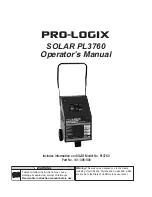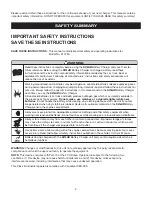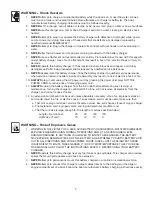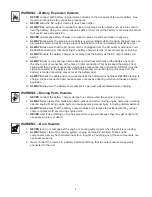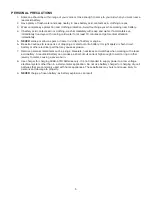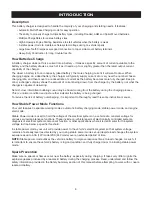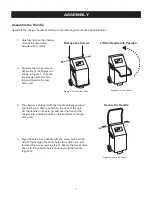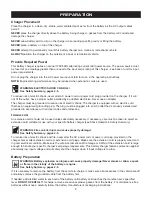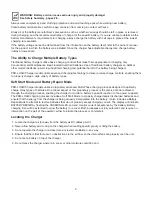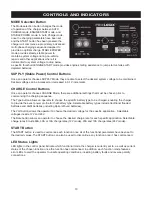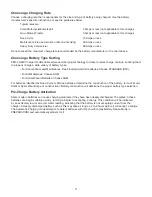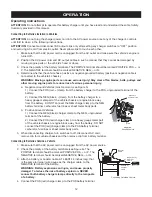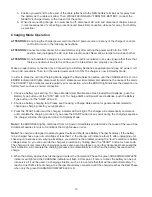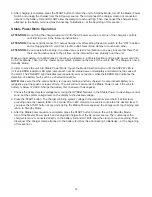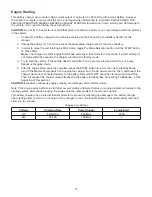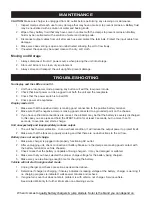
4
WARNING – Battery Explosion Hazards
1.
NEVER
connect both battery charger clamps directly to the two posts of the same battery. See
Operation Instructions
for connection procedures.
2.
NEVER
allow the DC output clamps to touch each other.
3.
ALWAYS
be extra cautious to reduce the risk of dropping a metal object, such as a tool, onto or
near the battery. Doing so could produce a spark or short circuit the battery or other electrical part
that could cause an explosion.
4.
NEVER
operate the battery charger in a closed-in area or restrict ventilation in any way.
5.
ALWAYS
make sure the area around a battery is well ventilated while it is being charged. Gas can
be forcefully blown away by using a piece of cardboard or other non-metallic material as a fan.
6.
ALWAYS
make sure that the AC power cord is unplugged from the AC outlet or extension cord
BEFORE connecting or disconnecting the battery charger clamps, to prevent arcing or burning.
7.
ALWAYS
locate the battery charger as far away from the battery as the DC output cables will
permit.
8.
ALWAYS
twist or rock charger clamps back and forth several times on the battery post and
the other point of connection at the time of initial connection. This helps keep the clamps from
slipping off their points of connection which helps reduce the risk of sparking. DO NOT rock the
clamp connected to the battery post AFTER the second connection (at a point away from the
battery) is made or sparking may occur at the battery post.
9.
ALWAYS
check the cable and wire connections at the battery(s) for tightness BEFORE starting to
charge. A loose connection can cause sparks or excessive heating which could cause a battery
explosion.
10.
ALWAYS
make sure the battery compartment is open and well ventilated before charging.
WARNING – Moving Parts Hazards
1.
NEVER
connect the battery charger clamps to a vehicle when the engine is running.
2.
ALWAYS
stay clear of fan blades, fan belts, pulleys and other moving engine parts when working
near an engine. Moving engine parts can cause severe personal injury, including dismemberment.
3.
ALWAYS
make sure that the battery charger cables and clamps are positioned so they will not
come in contact with any moving engine parts.
4.
NEVER
wear loose clothing or long hair around moving parts because they may get caught and
cause severe injury or death.
WARNING – Burn Hazards
1.
NEVER
lean on or rest against the engine or cooling system parts when the vehicle is running.
2.
ALWAYS
stay clear of the cooling system, engine, and engine manifold. These engine
components get very hot and retain heat for a long time. Touching any of these components can
cause severe burns.
3. Never connect the clamps to a battery before confirming that the output cables are securely
connected to the unit.
WARNING
Read these instructions completely before using the Battery Charger and save them for future
reference. Before using the Battery Charger to charge a battery, read these instructions and the
instruction manual/safety information provided by the car, truck, boat or equipment manufacturer.
Following all manufacturers’ instructions and safety procedures will reduce the risk of accident.
Working around lead-acid batteries may be dangerous. Lead-acid batteries release explosive gases
during normal operation, charging and jump starting. Carefully read and follow these instructions for
safe use. Always follow the specific instructions in this manual and on the Battery Charger each
time you use the Battery Charger.
All lead-acid batteries (car, truck and boat) produce hydrogen gas which may violently explode in
the presence of fire or sparks.
Do not smoke, use matches or a cigarette lighter while near
batteries. Do not handle the battery while wearing vinyl clothing because static electricity sparks
are generated when vinyl clothing is rubbed. Review all cautionary material on the Battery Charger
and in the engine compartment.
Always wear eye protection, appropriate protective clothing and other safety equipment when
working near lead-acid batteries. Do not touch eyes while working on or around lead-acid batteries.
Always store clamps away from each other or common conductors. Improper storage of clamps
may cause the clamps to come in contact with each other, or a common conductor, which would
be hazardous if the charger was plugged into an AC outlet.
Use extreme care while working within the engine compartment, because moving parts may cause
severe injury. Read and follow all safety instructions published in the vehicle's Owner's Manual.
Batteries being charged with the Battery Charger
unit likely contain liquid acids which are
hazardous if spilled.
Failure to follow instructions may cause
damage or explosion, always shield eyes.
Read entire instruction manual before use.
WARNING

